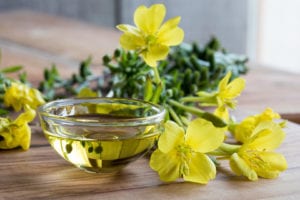Evening Primrose Extract Acts on Invasive Mesothelioma Cells, Study Shows

There is new evidence that compounds found in the seeds of the evening primrose plant have the potential to slow the growth and spread of mesothelioma.
Researchers in Poland extracted key compounds from the seeds using alcohol. They applied the extract (EPE) to malignant pleural mesothelioma cells in the lab.
Evening primrose extract seemed to have the biggest effect on the most invasive mesothelioma cells. The more EPE the researchers used, the greater the impact. The study suggests there may be a future role for evening primrose in mesothelioma therapy.
What is Evening Primrose?
The evening primrose is a plant with yellow flowers. Its seeds contain a range of polyphenols including ellagic acid, gallic acid, and catechin.
Oil extracted from the seeds has been used to treat a variety of conditions, including eczema, psoriasis, multiple sclerosis, diabetic neuropathy and cancer. It is classified as a “dietary supplement” under the Dietary Supplement Health and Education Act of 1994.
But the evidence for evening primrose in medical treatment is limited. The new Polish study is the first scientific analysis of its effect on mesothelioma cells.
Malignant mesothelioma is a virulent cancer. It grows on the membranes around internal organs and spreads quickly. There is no cure for mesothelioma and few reliable treatments. The three medications approved to treat mesothelioma only help a fraction of the patients affected. They can also make patients very sick.
This is why many scientists are exploring complementary and alternative treatments for mesothelioma. Compounds like curcumin, resveratrol, cannabis, and evening primrose may offer the hope that some patients are looking for.
Testing EPE on Mesothelioma Cells
Researchers at the Medical University of Lodz conducted the new study on EPE. They applied the compound to malignant pleural mesothelioma cells and recorded the results.
“EPE inhibited MPM growth in a dose-dependent manner in cells with increased invasion properties,” reports lead study author Malgorzata Chmielewska-Kassassir. “Moreover, EPE treatment resulted in cell cycle arrest in the G2/M phase and increased apoptosis in invasive MPM cell lines.”
Mesothelioma cells that were growing out of control started to die at a more natural rate again.
Evening primrose extract also blocked the secretion of a tumor-promoting enzyme called MMP-7. This enzyme is linked to cancer invasion and to development of blood vessels that feed tumors. Higher MMP-7 seems to promote metastasis in several other cancers.
“Our original data provide evidence about the potential anti-invasive effects of EPE in MPM therapy treatment,” the report concludes.
Should Mesothelioma Patients Take Evening Primrose Supplements?
The Polish study suggests that evening primrose may act on mesothelioma cells in the lab. But that is a long way from using it in patients. The next step would be animal studies to test the safety and effectiveness. Human trials would come after that.
For now, there is not enough evidence to suggest that mesothelioma patients should take evening primrose supplements. According to Mayo Clinic, “While evening primrose oil is probably safe for most people to take short term, research doesn’t support the use of the supplement as a treatment for any condition.”
These supplements can also cause headaches and nausea. And no one knows if they could interfere with cancer treatments.
Mesothelioma patients should talk with their doctor before taking any dietary supplement. Surviving Mesothelioma will continue to provide updates on alternative treatments such as evening primrose.
Sources:
Chmielewska-Kassassir, M, et al, “Polyphenol Extract from Evening Primrose ( Oenothera paradoxa) Inhibits Invasion Properties of Human Malignant Pleural Mesothelioma Cells”, November 19, 2020, Biomolecules, https://www.mdpi.com/2218-273X/10/11/1574
Evening Primrose Overview, Mayo Clinic website
EPO Chemical Review, National Toxicology Program, https://ntp.niehs.nih.gov/ntp/noms/support_docs/evening_primrose_nov2009.pdf





